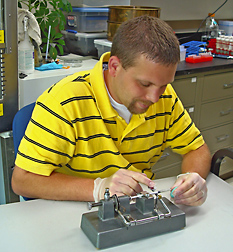Washington, DC
April 11, 2008
ARS News Service
Agricultural Research Service, USDA
By Laura
McGinnis
 |
|
Entomologist Denny
Bruck injects a larva of the tobacco hornworm,
Manduca sexta, with P. fluorescens Pf-5. Photo
by Joyce Loper. |
|
New research supported by the
Agricultural Research Service
(ARS) has revealed novel pseudomonad compounds and toxins with
potential benefits for plants and people. Pseudomonads are a
diverse group of bacteria, some of which harm plants and
animals, while others are beneficial.
Within every genome, there are
chunks of DNA whose functions are unknown. Some of these are
similar to genes that make natural products. Because scientists
don't know which specific natural products these genes make,
these segments are known as "orphan gene clusters."
According to
Joyce Loper, a plant pathologist at the ARS
Horticultural Crops Research Laboratory in Corvallis, Ore.,
it's likely that some orphan gene clusters produce natural
products that could become new antibiotics. Identifying these
gene clusters and their products would give scientists new tools
that can be used to fight harmful microorganisms.
Working with scientists at
Scripps Institution of
Oceanography at
University of
California-San Diego,
Oregon State University, and
Northland College
in Ashland, Wis., Loper investigated a new method for
determining the products of orphan gene clusters.
The scientists used what they
call a "genomisotopic" approach, which combines genomic sequence
analysis and isotope-guided fractionation, the process of
isolating compounds.
Loper and her colleagues
applied the genomisotopic method to the genome of the bacterium
Pseudomonas fluorescens Pf-5, a biological control agent
that protects plants from diseases. Scientists have long known
that Pf-5 makes antibiotics, but by using the method, they've
identified two antibiotics that had never been seen before.
These studies were funded
jointly by ARS, the National
Institutes of Health, the
German Research Foundation, and the Microbial Genomic
Sequencing Program, an initiative of the USDA Cooperative State
Research, Education and Extension Service (CSREES).
In 2007, CSREES funded the sequencing of seven additional
Pseudomonas species, four of which are under investigation
in ARS laboratories.
Further research could identify
new natural products with valuable properties, with potential
for use in antibiotics, drugs or pesticides.
Read more about this research in the April 2008 issue of
Agricultural Research magazine.
ARS is the
U.S.
Department of Agriculture's chief scientific research
agency.
Una nueva investigación
patrocinada por el Servicio de Investigación Agrícola (ARS)
ha llevado al descubrimiento de nuevos compuestos y toxinas de
las bacterias Pseudomonas que ofrecen beneficios potenciales
para las plantas y la gente. Las bacterias Pseudomonas son un
grupo diverso de bacterias, incluyendo algunas que pueden
perjudicar las plantas y los animales, y otras que son
beneficiosas.
Dentro de cada genoma, hay
pedazos de ADN que tienen funciones no conocidas. Algunos de los
genes en estos pedazos son semejantes a otros genes que hacen
productos naturales. Ya que los científicos no saben cuáles
productos naturales específicos son producidos por estos genes
con funciones no conocidos, esos segmentos de ADN se llaman
"grupos de genes huérfanos".
Según
Joyce Loper, quien es patóloga de plantas en el
Laboratorio de Investigación de Cultivos Hortícolas
mantenido por el ARS en Corvallis, Oregón, es probable que
algunos grupos de genes huérfanos produzcan productos naturales
que podrían darles a los científicos nuevas herramientas que
podrían ser usadas para combatir microorganismos perjudiciales.
Junto con científicos en la
Institución Scripps de
Oceanografía en la
Universidad de
California-San Diego, la
Universidad Estatal de Oregón, y el
Colegio Northland
en Ashland, Wisconsin, Loper investigó un nuevo método para
identificar los productos hechos por los grupos de genes
huérfanos.
Los científicos usaron lo que
ellos llaman "el enfoque genomisotópico", el cual combina el
análisis de secuencias genómicas y el fraccionamiento isotópico,
el cual es el proceso de aislar compuestos.
Loper y sus colegas aplicaron
el método genomisotópico al genoma de la bacteria Pseudomonas
fluorescens Pf-5, un agente de control biológico que protege las
plantas contra enfermedades. Los científicos han sabido por
mucho tiempo que Pf-5 hace antibióticos, pero con utilización de
este método, ellos han identificado dos antibióticos que nunca
se han visto antes.
Estos estudios fueron
patrocinados por el ARS, los
Institutos Nacionales de la Salud, la
Fundación Alemana de
Investigación, y el Programa de Secuenciación de Genomas
Microbianos, el cual es una iniciativa del Servicio Cooperativo
Estatal de Investigación, Educación e Instrucción (CSREES
por sus siglas en inglés), una agencia del
Departamento de Agricultura de
EE.UU. (USDA por sus siglas en inglés). En el 2007, CSREES
patrocinó la secuenciación de siete especies adicionales de
Pseudomonas, incluyendo cuatro que están siendo investigadas en
los laboratorios del ARS.
Investigaciones adicionales
podrían identificar nuevos productos naturales con propiedades
valiosas, con potencial para utilización en antibióticos,
medicinas o pesticidas.
Lea más sobre esta investigación en la revista 'Agricultural
Research' de abril 2008.
ARS es la agencia principal
de investigaciones científicas del USDA. |